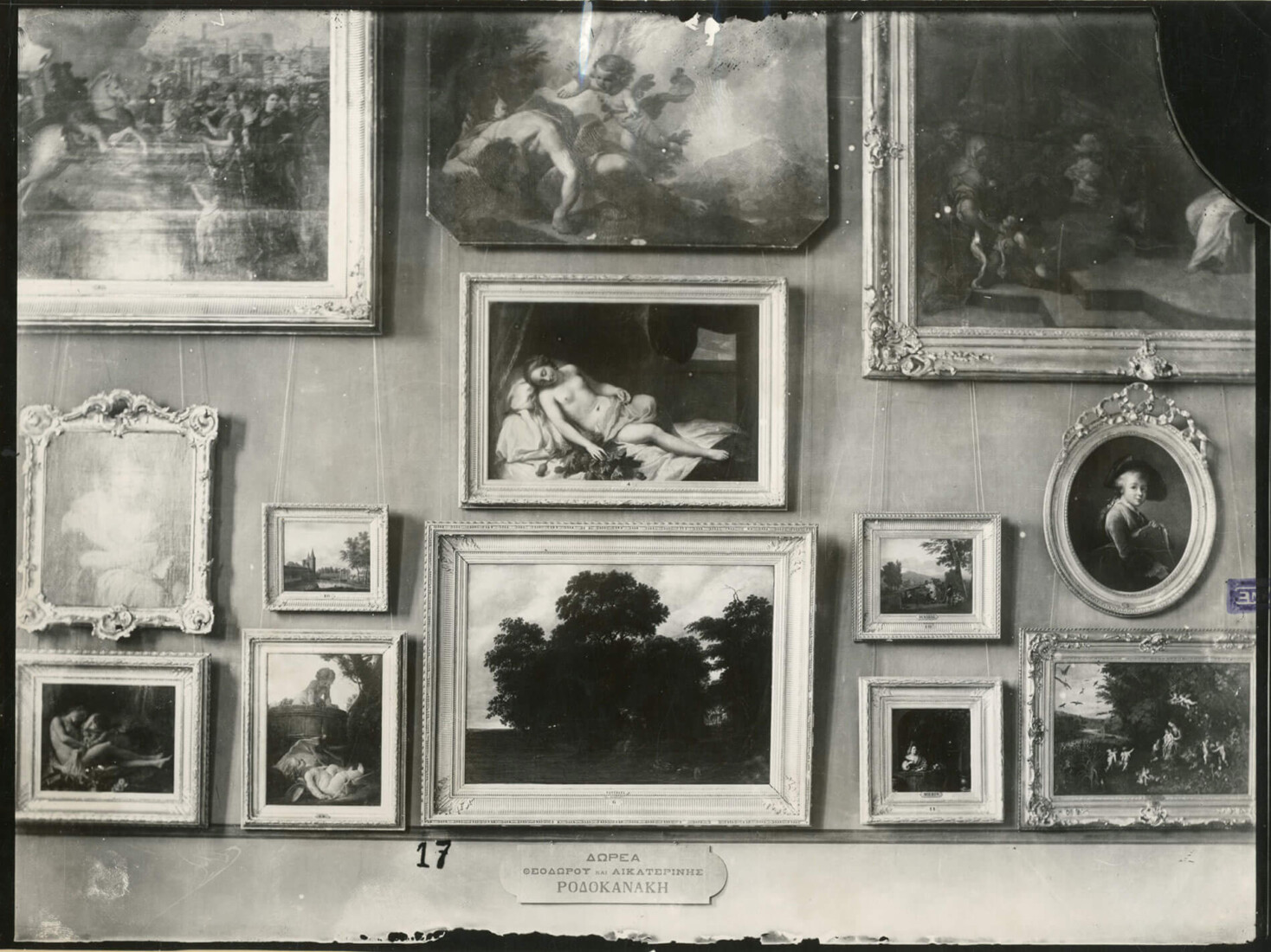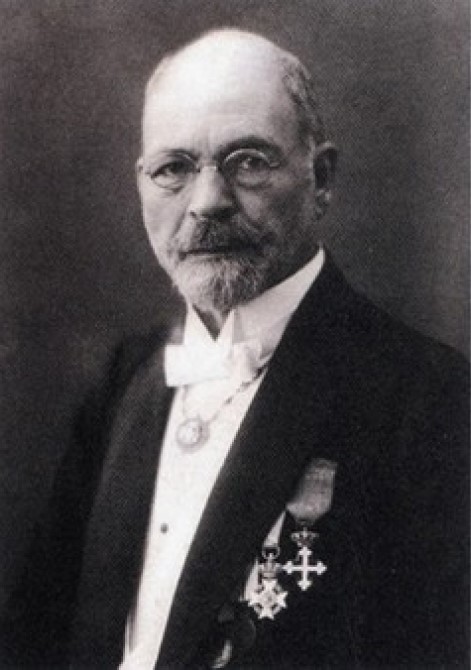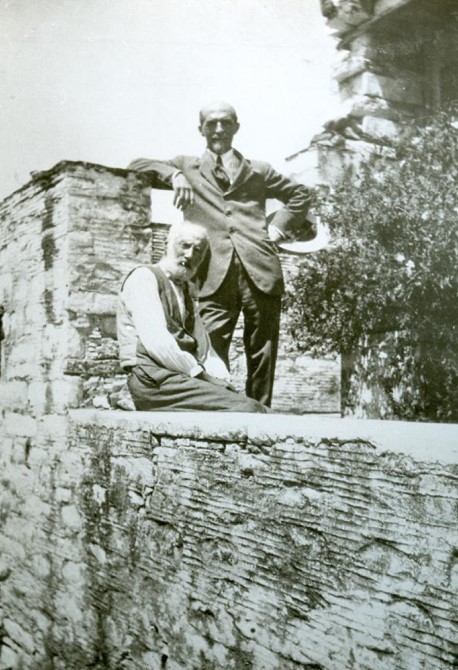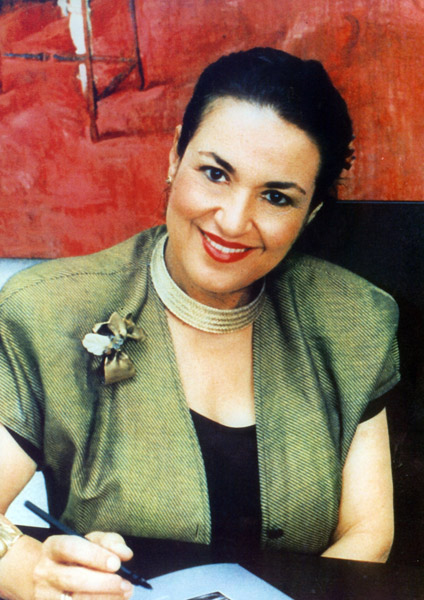The care for the creation of artistic collections is almost contemporaneous with the independent Greek state and expresses the desire of the Greeks to see a renaissance of the arts in what has been their ancient cradle. In 1836, the famous Bavarian architect Leo von Klenze draws a magnificent plan, proposing a “Pantechnion,” aspiring to host not only the archaeological collections and the School of Arts, but also an Art Gallery. This imposing hall of the arts was never to materialize. In 1878, the first nucleus of the Gallery, comprising 117 works by Greek and European artists, mainly envisaged as an educational annex to the School of Arts, was established in the Technical University of Athens and opened for the public.
In 1896, Alexandros Soutsos, a jurist and art lover, bequeathed his collection and estate to the Greek State aspiring to the creation of a “Museum of Fine Arts”. The National Gallery eventually came into being by an April 10, 1900 decree and an invitation to the painter Georgios Iakovidis to return from Munich. He became its curator in July 28, 1900. Originally in the Technical University and the University collections, a total of 258 works were donated to the newly established Gallery; the 107 works donated by Alexandros Soutsos followed suit in 1901.

Georgios Iakovidis (1853-1932)
The Gallery was founded on 10 April 1900 by Law ΒΨΛΔ΄, which provided for a supervisor; the painter Georgios Iakovidis (1853-1932) was appointed to this post. On June 28 1900, the Gallery’s rules of operation were laid down, according to which the artworks in its collection were divided into six sections, including ‘Byzantine… Medieval… Modern art (oil paintings)… watercolours, pastels and drawings… copies of paintings in other collections, and prints (woodcuts, copper engravings and other kinds of engravings…)’. The collection core consisted of 258 works of art from the collections of the National Technical University (NTUA) and the University of Athens, which were delivered to Georgios Iakovidis by NTUA’s director, Anastassios Theofilas, on 28 July 1900, as well as by the collection of lawyer and art connoisseur Alexandros Soutsos (1839-1895), who bequeathed his estate to the Greek state for the purpose of establishing and maintaining a museum of painting. His collection was delivered by Natalia Soutsou on 21 June 1901.
On 24 February 1906, a royal decree was issued, whereby a six-member supervisory committee was appointed, consisting of leading personalities of the country’s political and entrepreneurial life: the later prime minister, Stefanos Skouloudis, and Stefanos P. Rallis, Markos Dragoumis, Petros Kalligas, Spyridon Stais and ThemosAnninos. The committee, in co-operation with the supervisor, was responsible for displaying, enriching, developing and preserving the gallery’s collections. In addition, the Gallery secured financial support – 3,000 Drachmas per year – for the first time, from the bequest of the Greek-diaspora benefactor, Dimitrios Doridis, who had left his fortune to the Greek nation to be used in public institutions.
Collection enrichment was facilitated by adopting laws that ensured the allocation of art works to the Gallery, as well as by generous contributions by individuals inside and outside Greece. In this context, on 6 April 1911, the Georgios Averoff Estate Trustees donated to the Gallery the 80 paintings in Averoff’s collection, as well as 15 more, acquired with the estate’s funds, all of which went on display in a room of their own, named ‘Averoff Art Gallery’, according to the donor’s wish.
The first major exhibition of works from the Gallery’s collection was announced in 1912, but only opened in 1915. Some 300 paintings, conserved by the painter Georgios Hatzopoulos, were shown in six large NTUA rooms.
In collaboration with the supervisory committee, Georgios Iakovidis also made strenuous efforts to resolve the housing issue, as the Gallery was in need of housing of its own, having been housed since its founding on the upper floor of NTUA’s main building. These efforts fell through due to disagreement over the building’s architectural style and location. In 1914, by law 477, a plot of land on Vassilissis Sofias Avenue and Rizari Street had been allocated; however, the building was not constructed, due to the objections of the military, to which the site belonged.
Nevertheless, in order to further the Gallery’s educational programme, Iakovidis introduced free admission for the public every Saturday and Sunday to NTUA’s rooms, which also served as an exhibition venue. He also published the Gallery’s first catalogues, in 1906 (which included the rules of operation) and 1915; moreover, he succeeded in securing two positions for ‘curators’, as conservators were called at the time, taken up by the painters Georgios Hatzopoulos and Odysseas Fokas.
Zacharias Papantoniou (1877-1940)
Georgios Iakovidis served as the Gallery’s supervisor until 1918. Under Liberal administration, Bill 1434 ‘On establishing the National Gallery’ came into force, in 1918 – it was the first effort to overhaul and improve the museum’s administrative and financial status. Among other things, the law abolished the position of a supervisor, which until then was held by Georgios Iakovidis, and instituted the post of a director, which was taken by the writer and art critic Zacharias Papantoniou. In addition, an annual grant from the ministry’s budget was set up for collection enrichment, for the first time, and a Board for artistic matters was established to advise the Ministry on acquisitions and donation acceptance, in place of the supervisor and the supervisory committee. The first Art Board consisted of Georgios Iakovidis (chairman) and members Zacharias Papantoniou, Georgios Hatzopoulos, the writer Konstantinos Hatzopoulos and the painter Konstantinos Maleas. The same law instituted, also for the first time, the sculpture collection.
Papantoniou sought to resolve the Gallery’s major issues, unsuccessfully. He worked towards the merger of the National Gallery and the estate of lawyer and art connoisseur Alexandros Soutsos (1839-1895), who bequeathed his estate to the Greek state for the purpose of establishing and maintaining a museum of painting. In 1926, to resolve the housing issue, in cooperation with the Soutsos Estate Trustees, he acquired the Iliou Melathron, but cancelled the acquisition when he found out that the building was not suitable for a museum.
Acquisitions to enrich the collections using the annual subsidy by the ministry, or special state subsidies involved works mainly by Greek artists, including Nikolaos Doxaras, Nikolaos Kantounis, Nikolaos Gyzis, Nikephoros and Nikolaos Lytras, Konstantinos Maleas, Dimitris Galanis, Panos Aravantinos, Konstantinos Parthenis, Nikolaos Cheimonas, Periklis Pantazis and Vassilios Hatzis, so as to provide a representative overview of painting from the Ionian School to modern times.
In 1931, moreover, the National Gallery’s most important acquisition was made at auction in Munich: Domenikos Theotokopoulos’s Concert of the Angels, the upper part of his Annunciation, was acquired for the sum of 5,900,775 Drachmas.
Under Zacharias Papantoniou, the sculpture collection was also inaugurated. Thus, in 1934, the new permanent display of the painting collection featured sculptures for the first time. Papantoniou also opened the museum to the public on a daily basis, introducing visiting hours with free admission.
The 1940s
Zacharias Papantoniou’s term of office was interrupted by his death in February 1940. Two months later, the painter and conservator Georgios Stratigos (1876-1944) took over as the National Gallery’s director, but his office was also cut short when he died in November 1944. On 26 August 1945, the archaeologist Dimitrios Evanghelidis (1886-1959) temporarily took over as director, remaining in this position until 28 February 1947. On 1 March 1947, he was succeeded by the archaeologist and art historian Nikolaos Bertos (1885-1949), whose tenure was also interrupted by his death on 11 January 1949.
During the War and the German occupation, the main concern was to safeguard the artworks, which were transferred to the Archaeological Museum and the most valuable among them to the Bank of Greece treasury. In the meantime, since January 1941, the Gallery had been forced to move out of the main NTUA building, which was requisitioned to host a military hospital for the wounded and later used by the German occupation army. Its premises were immediately re-occupied by the NTUA, on the grounds that the number of students and therefore the teaching needs had increased. Thus, the Gallery was temporarily housed in the Benaki Museum, followed by successive relocations to Casa d’ Italia and the Archaeological Museum, where the art collections were transferred in 1948.
The museum’s limited operation in the 1940s only permitted minimal enrichment of the painting collection. Nevertheless, in 1946, the Gallery received a very generous donation. Odysseas Fokas, a ‘curator’ (conservator) since 1915, bequeathed his movable and immovable property ‘for the enrichment of the international modern art section’. His bequest made Fokas the second great benefactor, following Alexandros Soutsos.
In addition, after the Liberation, a substantial donation of French artists’works was made – in tribute to the Greek people’s heroic stance during the German occupation – an idea put forth in 1942 by intellectual and literary figure Roger Milliex and his companion, Tatiana Gritsi-Milliex. It comprised 28 paintings, 6 drawings, 6 engravings, 4 sculptures and 2 books, delivered to the National Gallery in July 1949.
Marinos Kalligas (1906-1985)
In 1954, Law 2814 ‘On the establishment of a legal entity of public law under the name “National Gallery and Alexandros Soutsos Museum”’ came into force, whereby the Alexandros Soutsos Estate was merged into the National Gallery. With the merger, the supervisory committee was replaced by a seven-member Board of Directors, and substantial financial support was secured, in addition to state funding, which contributed to the acquisition of permanent housing, as well as to the enrichment of the collections and the library.
Since 1952 and for at least four years, the National Gallery was housed on two floors on 11, Kolokotroni Street, formerly housing the Ministry of Merchant Marine. Subsequently, both the administration and artworks moved to the Artillery barracks at the corner of Rizari Street and Vassilissis Sofias Avenue. In 1956, however, a competition had been launched for the construction of a building. After many delays and complications related to plot location, construction of the first of the current buildings began, on 26 November 1964. It was completed in 1968, and the first exhibition with works from the collections was inaugurated on 14 May 1970. Meanwhile, in 1968, the National Gallery had once again been forced to move, this time to an apartment at the corner of Efroniou Street and Vassileos Alexandrou Avenue. The artworks went into storage in the building’s basement.
As regards acquisition of artworks, under Marinos Kalligas the enrichment of the collections became more systematic through both acquisitions and donations; the latter were often the result of the director’s personal encouragement. Thus, the painting collection was enriched with works by both older and younger artists, becoming representative of the most remarkable exponents of all periods and movements. The sculpture collection was augmented, providing a more complete overview of the Ionian sculptors until the modern era; the engraving collection received high-quality prints, including by French artists as well as Rembrandt, Pieter Bruegel the Elder, Dürer, and Goya. In addition, on a voluntary-work basis, artworks were catalogued, and the archives were organised.
Until the housing issue was resolved, a temporary solution was provided for public display of art between 1953-1959, by organising exhibitions from the Gallery’s collections at the Zappeion Hall. To accompany these exhibitions, small yet quite detailed catalogues were published (1953, 1954, 1955/1, 1955/2, 1956, 1957) the first ones to follow those published by Georgios Iakovidis in 1906 and 1915. Temporary exhibitions were also organised, including a selection from Stavros Niarchos’ collection in 1958, as well as exhibitions from the collections of the National Gallery in other cities (1955, 1962/1, 1962/2).
Andreas Ioannou (1918-1972)
Following Marinos Kalligas, the lawyer and former prefect Andreas Ioannou (1918-1972) was appointed as director of the National Gallery; however, his term was cut short by his death in August 1972.
During Andreas Ioannou’s brief tenure, Alexandros Iolas made a substantial donation of seven artworks by contemporary, mainly foreign artists.
Dimitris Papastamos (1923-2008)
In December 1972, the archaeologist and art historian Dimitris Papastamos (1923-2008) took over the direction of the National Gallery, remaining in this position until October 1989.
During Dimitris Papastamos’s tenure, the National Gallery was firmly consolidated, the result of the final resolution of the question of housing and a radical administrative overhaul.
In 1976, the second part of the building complex was completed. The National Gallery was officially inaugurated on 17 May 1976 by the President of the Hellenic Republic, Konstantinos Tsatsos, and Prime Minister Konstantinos Karamanlis.
In 1980, Law 1079 was passed, which regulated the structure and operation of the National Gallery – Alexandros Soutsos Museum. This law abolished most of the provisions of Law 2814/1954 and instituted new activities, enabling the collections to be expanded and the museum departments to be reorganised and developed in line with modern requirements.
Thus, the National Gallery agencies were set up as a Directorate General with three Directorates: i. Collections, Artistic and Museological Programming, ii. Administrative-Accounting, and iii. Art Conservation and Restoration. Staff growth was spectacular and covered all the requisite specialties, while the curation of the collections was for the first time assigned to art historians, who also catered to their systematic organisation.
The collections were enriched, alongside substantial donations of artworks by artists including Tassos, Nikolaos Ventouras, Giorgos Moschos, Konstantinos Parthenis, Umvertos Argyros, Giorgos Gounaropoulos, Nikos Hadjikyriakos-Ghika and Yannis Moralis. Also, Eugène Delacroix’ Greek Fighter on Horseback was acquired, thanks to the support of Stavros Niarchos and Vassilis Goulandris; the large-scale fresco by Fotis Kontoglou installed in the artist’s home was acquired with support from Vassilis and Nikos Goulandris; and Rodin’s The Prodigal Son was acquired with funds from Odysseas Fokas’ bequest as well as a financial contribution by Vassilis Goulandris.
The resolution of the housing issue enabled the permanent display of the collections, which since 1977 included works from the Evripidis Koutlidis collection. Moreover, extensive and systematic exhibition activity was developed, with added emphasis on the promotion of Greek artists’ work. There were also exhibitions by foreign artists, many of which took place in the context of transnational exchanges, as well as some outstanding group exhibitions. Exhibitions were also organised in other countries as well as all around Greece, aiming at promoting visual arts education, especially among school children. A variety of art events, lectures, conferences, theatrical performances of children’s plays and puppet theatre were also organised, and a children’s workshop was set up.
In 1983, the Coumantaros Art Gallery was established in Sparti, becoming the first National Gallery Annexe.
Finally, with the financial contribution of the painter and engraver Koula Bekiari-Vekri, the first Glyptotheque was established in 1986 in independent premises in the museum and remained in operation until the early 1990s. This was the first independent permanent display of the National Gallery’s collection of sculpture and traced the evolution of Modern-Greek sculpture until 1940.
Mary Michailidou
Following Dimitris Papastamos, Mary Michailidou, Head of the Department of Folk Culture of the Hellenic Ministry of Culture, became the Chief Executive Officer since November 1989. In April 1990, she was appointed as director, serving until 14 June 1991.
During her tenure, Mary Michailidou organised a new display of part of the National Gallery’s collections, featuring 19th-century art. Retrospective exhibitions of the oeuvre of mainly Greek but also foreign artists were also organised.
Following Mary Michailidou, Nelly Missirli, Head of the Directorate of Collections, Artistic and Museological Programming of the National Gallery, was appointed as director, remaining in this position until January 1992. As early as the summer 1991, the post was advertised, and since 17 January 1992 the National Gallery has been headed by the art historian and professor at the Athens School of Fine Arts, Marina Lambraki-Plaka.
Marina Lambraki Plaka (1936-2022)
Born in Arkalohori in Heraklion, Crete. Graduate of the Department of History and Archaeology, University of Athens (1959-1964). Postgraduate studies in Classical
Archaeology at the University of Athens, on scholarship from the State Scholarship Foundation (SSF); subject: “Pre-Socratic Philosophy and Art”.
Attended the History of Art lectures by Professor Pantelis Prevelakis at the Athens School of Fine Arts (1965-1968). Postgraduate studies in the History and Sociology
of Art at Paris I, Sorbonne on SSF scholarship (1968-1971). Doctorat d’État ès Lettres with honours at Paris I, Sorbonne on Bourdelle and Greece (1973).
Unanimously elected Professor at the Chair of History of Art at the Athens School of Fine Arts (1975). First woman professor in the history of the Athens School of Fine Arts.
Visiting fellow at Princeton University on Fullbright Scolarhip. Visiting professor at several universities in France, the U.S. and the School of Philosophy of the
University of Crete at Rethymnon.
DIRECTOR OF THE NATIONAL GALLERY-ALEXANDROS SOUTSOS MUSEUM FROM 1992 TO 2022.
During her tenure as director, the National Gallery was refurbished, new annexes opened (Corfu, Nafplio, the National Glyptotheque at Goudi, the Kapralos Museum on
Aegina), 3,000 works of art were acquired, including two masterpieces by Theotokopoulos (El Greco), major exhibitions by Greek and international artists were organized
and well-received, logging approximately 5.5 million visitors. All these activities were funded between 60-100% by sponsorship.
After several years of efforts, the study for the expansion of the National Gallery building has been completed, more than doubling the gallery’s exhibition space and
updating the museum in form and function. The project, funded by NSRF and sponsored by the Stavros Niarchos Foundation, was carried out under the
technical supervision of the Ministry of Culture and was completed in 2021.
HONORARY DISTINCTIONS
Kazantzakis Prize of the City of Heraklion, Crete (1985)
1st State Prize for Essay and Criticism for the book On Painting – Alberti and Leonardo (1988).
Knight of the Order of Arts and Letters of the Italian Republic (1994)
Commander of the Order of Arts and Letters of the Italian Republic (2007)
Knight of the Order of Arts and Letters of the French Republic (1997)
Commander of the Order of Arts and Letters of the French Republic (2005)
Knight of the Order of Legion of Honour of the French Republic (2011)
Medal of the Civil Order of Alfonso X, the Wise by the Spanish Ministry of Culture (2000)
Gold Cross of the Order of Merit by the President of the Hellenic Republic (2004)
TEI of Crete Award (2005)
Lions International Award (2006)
XENIA Award (2006)
“Ariadne” Award by the Pancretian Union of America (2009).
Elected Vice-President of AICA International
Elected Greek Candidate for the “Woman of Europe” Award (2007)
Appointed Alternate Minister of Culture in the Caretaker Government of September 2015
She had published 21 books and more than 200 papers and articles in academic magazines and newspapers; has written more than 100 essays for exhibition catalogues.
She had participated in numerous academic conferences in Greece and abroad.




